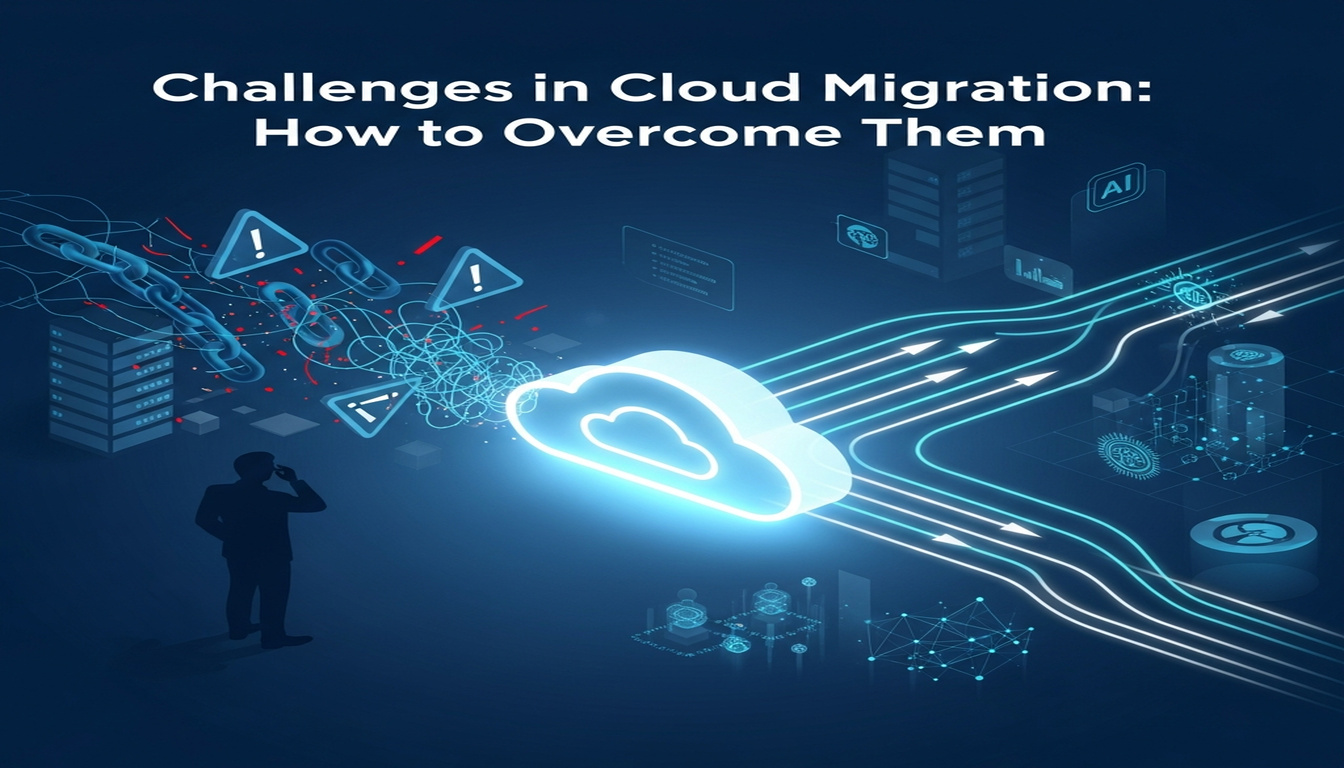Challenges in Cloud Migration: How to Overcome Them
DSSP2025-11-10T16:36:04+00:00INTRODUCTION:
Every modern business dreams of the cloud.Faster speed. Lower cost. Smarter data.On paper, cloud migration looks like the most logical step in digital transformation.But if you’ve ever been part of one, you already know the truth, migrating to the cloud isn’t just a technical process. It’s a test of leadership, culture, and patience.Across the U.S., from Fortune 500s to small startups, CIOs face similar roadblocks: complex systems, unpredictable costs, security fears, and people who just aren’t ready to change.
Let’s face it, challenges in cloud migration are real. But they can be overcome.This guide takes a human-centered look at what goes wrong, why it happens, and how to get migration right the first time.
What Is Cloud Migration, Really?
Cloud migration means moving data, applications, or entire infrastructures from on-premises systems to the cloud. Sounds simple but under the surface, it’s a complete rewiring of how your organization operates.Imagine packing up your entire business, moving it into a digital skyscraper, and still keeping every department running mid-move. That’s what migration feels like.
Most companies in the U.S. migrate for four main reasons:
- To reduce IT costs
- To improve scalability and speed
- To enable remote collaboration
- To prepare for AI and data-driven innovation
Yet despite the clear benefits, more than 70% of cloud migration projects face delays or cost overruns. Why? Because leaders often underestimate the human, technical, and cultural challenges.
Why Do Cloud Migration Challenges Happen?
The problem isn’t the cloud, it’s how we approach it.Leaders think of migration as a technical lift, not a strategic shift. They rush to adopt tools before understanding how people, processes, and systems must evolve together.Let’s explore the most common challenges in cloud migration that organizations across the U.S. encounter and what to do about them.
1️⃣ Legacy Systems That Don’t Want to Move
Legacy systems are like old roots deep, tangled, and difficult to pull up.Many U.S. enterprises still rely on applications built a decade ago. These systems weren’t designed for the cloud, making them hard to migrate without breaking dependencies.
Why it happens:
- Custom-coded apps tied to outdated hardware
- Lack of documentation
- Compatibility issues with modern APIs
How to fix it:
Start with assessment. Use discovery tools to map every dependency.
Prioritize which apps to rehost, re-platform, or refactor. Sometimes, the best move isn’t to lift and shift, it’s to rebuild with cloud-native principles.Migration isn’t about moving everything; it’s about moving what matters.
2️⃣ Unclear Cloud Strategy
A surprising number of businesses move to the cloud without a clear plan. They start migrating workloads, then realize halfway through they don’t have a governance model, security framework, or cost visibility.
Why it happens:
- Pressure to “move fast” from executives
- No alignment between IT and business goals
- Lack of migration roadmap
How to fix it:
Treat cloud migration as a business transformation, not an IT project.
Build a roadmap that defines:
- Why you’re migrating
- What workloads move first
- Who owns each stage
- How success will be measured
Companies that align business objectives with technical strategy reduce migration time by up to 40%.
3️⃣ Data Security and Compliance Risks
Every CIO knows this fear: “What if we lose data during migration?”Security is one of the biggest challenges in cloud migration because sensitive data is constantly moving between systems. One small misconfiguration can open a door to attackers.
Why it happens:
- Insecure data transfers
- Weak identity management
- Misconfigured cloud permissions
- Gaps in compliance policies (HIPAA, GDPR, FedRAMP)
How to fix it:
Security must move left built in from day one.Encrypt data at rest and in transit, use Zero Trust frameworks, and set clear access controls.
Work with compliance experts to validate every step.
Remember: the safest cloud migration is the one with no surprises.
4️⃣ Cost Overruns and Budget Shock
Here’s the irony most leaders move to the cloud to save money, yet many end up spending more.Why? Because they underestimate hidden costs like data transfer fees, idle instances, and poorly sized virtual machines.
Why it happens:
- Lack of cost visibility
- Unoptimized resource allocation
- No budget guardrails or alerts
How to fix it:
Implement FinOps (Cloud Financial Operations) practices.
Set automated alerts for usage spikes, right-size workloads, and track spending daily.
Public cloud costs can spiral if left unchecked but with governance, they stay predictable.
Pro tip:
Use cost calculators from AWS, Azure, or Google Cloud before migration. They’re not perfect, but they help you stay realistic.
5️⃣ Downtime and Performance Disruptions
Downtime during migration is every IT leader’s nightmare.Applications go dark, users panic, and customers lose trust. Even a few minutes of outage can cost large U.S. enterprises thousands of dollars.
Why it happens:
- Poor migration sequencing
- Missing backups
- Underestimated dependencies
How to fix it:
Plan migrations in phases.Use canary releases or pilot migrations to test small portions first.Back up everything before moving.And most importantly communicate with stakeholders. When people know what to expect, downtime doesn’t become a crisis.
6️⃣ Lack of Skilled Talent
Even the best tools fail without skilled people behind them.
A Gartner study found that two out of three migration delays are due to talent shortages. Many teams lack experience with cloud-native tools, automation frameworks, or container orchestration.
Why it happens:
- Legacy IT skill gaps
- Limited training budgets
- Overreliance on consultants
How to fix it:
Build cloud fluency internally. Upskill employees through certifications and labs.Encourage a learning culture not just at the technical level but across business functions.The most successful U.S. companies treat migration as a training ground for innovation.
7️⃣ Resistance to Change
You can buy the best technology in the world, but people must still use it.Resistance to change remains one of the most underestimated challenges in cloud migration.
Why it happens:
- Fear of job loss or role change
- Lack of communication about “why” the migration matters
- Poor change management strategy
How to fix it:
Bring employees into the journey early.Share the “why” behind the migration, not just the “what.”Celebrate small wins the first successful workload, the first faster deployment.Cloud adoption succeeds when culture shifts from fear to curiosity.
8️⃣ Multi-Cloud and Vendor Lock-In
Many U.S. companies start with one provider, then realize later they’re tied down switching becomes expensive or nearly impossible.
Vendor lock-in is a hidden cloud trap.
Why it happens:
- Relying too heavily on proprietary tools
- Ignoring portability in architecture
- No exit strategy
How to fix it:
Design for portability from the start.Use open APIs, containerization (Kubernetes), and abstraction layers to stay flexible.Some businesses even adopt a multi-cloud strategy distributing workloads across AWS, Azure, and Google Cloud to minimize dependency.Choice equals resilience.

9️⃣ Integration with Existing Systems
Hybrid setups bring their own complexity. Old systems need to talk to new ones.
Sometimes that’s easy. Often, it’s not.
Why it happens:
- API mismatches
- Inconsistent data formats
- Missing middleware
How to fix it:
Invest in integration architecture early.Use middleware or data fabric platforms to bridge systems.Document workflows thoroughly integration isn’t just a tech job; it’s communication across teams.
10️⃣ Lack of Governance and Monitoring
The final and most common mistake is forgetting governance after migration.Without proper monitoring, costs climb, performance drops, and compliance gaps reappear.
Why it happens:
- Focus ends after go-live
- No central ownership of governance
- Reactive, not proactive monitoring
How to fix it:
Set up a Cloud Center of Excellence (CCoE) a small cross-functional team that monitors policies, performance, and costs.Automation tools like AWS CloudWatch or Azure Monitor can track issues before they escalate.
How to Overcome Cloud Migration Challenges: A Proven Path
Let’s turn lessons into a practical plan, one that works for real companies.
- Assess before you act.
Don’t migrate blind. Audit infrastructure, dependencies, and business priorities first. - Build a roadmap.
Define stages, ownership, and metrics for success. - Start small, scale fast.
Move non-critical workloads first to build momentum and trust. - Empower people.
Train, communicate, and celebrate small wins. - Embed security.
Make it part of the process, not an afterthought. - Measure everything.
Use analytics and FinOps to track performance, uptime, and cost efficiency.
Migration isn’t an event. It’s a journey a living system that evolves with your business.
Real-World Case Studies
Netflix: Migrated from data centers to AWS over seven years. Faced massive complexity, but by breaking the journey into microservices, it achieved global scalability and resilience.
Capital One: Adopted a multi-cloud approach with strong governance. Now leads in security and real-time analytics among U.S. banks.
Adobe: Transitioned from packaged software to cloud services. Overcame resistance through internal culture change and customer-first focus.
These companies didn’t just survive migration they turned it into momentum.
When Is the Right Time to Migrate?
Timing matters.Move too fast, and you risk chaos. Move too slow, and competitors pass you.
You’re ready for migration when:
- On-prem systems limit growth.
- Your team understands cloud fundamentals.
- You have leadership commitment and clear ROI metrics.
In short migrate when your vision is ready, not just your servers.
Conclusion
Cloud migration isn’t easy and it’s not supposed to be.It forces organizations to rethink how they build, secure, and innovate.Yes, there are hurdles from cost surprises to cultural friction but every challenge is also a checkpoint of maturity.The secret is to treat migration not as a disruption, but as evolution. Because the real Digital transformation isn’t moving data; it’s moving mindsets.







Leave a Reply